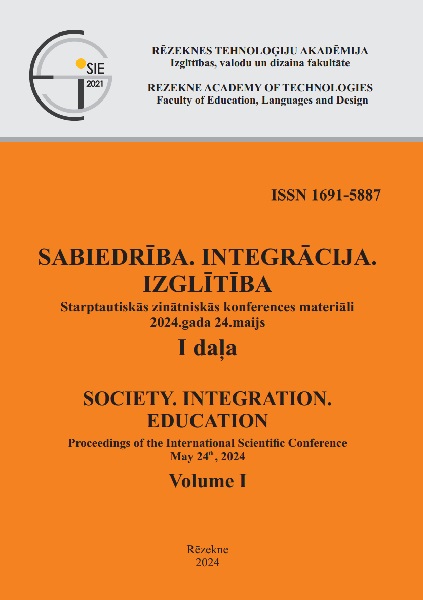STUDENTS’ VISUAL LITERACY DEVELOPMENT IN PRIMARY SCHOOL: THE INFLUENCE OF TEACHERS’ ABILITY TO VISUALIZE EDUCATIONAL INFORMATION
DOI:
https://doi.org/10.17770/sie2024vol1.7913Keywords:
primary school, primary school teachers, teachers’ visualizing skills, visual literacy, visualizing educational informationAbstract
In modern digital society visual content is an integral part of human life. Developing visual literacy strongly which is connected with such soft skills as critical thinking, creative thinking, communicating and collaborating is an important aspect in school education. The research is aimed at demonstrating the dependence of primary school students’ visual literacy on the primary school teachers’ abilities to visualize effectively educational information in the process of teaching.
The survey was conducted within the time period of 2019–2023. The team of researchers from Institute of Pedagogy of National Academy of Educational Sciences of Ukraine (Didactics Department) carried out an exploratory study within the primary school system in Ukraine. The total number of respondents consisted of 52 primary school teachers and 415 students.
The study finds out that nowadays the primary school teachers’ visualizing educational information skills are not sufficiently developed. Boosting the development of visualizing educational information skills among primary school teachers will be resulted in primary school students’ visual literacy development.
Having significant positive effect on primary school students’ visual literacy development the mentioned primary school teachers’ skills guarantee serious positive impact on learning results of primary school students in total.
References
ACRL. (2022). The framework for visual literacy in higher education. Retrieved from: https://www.ala.org/acrl/sites/ala.org.acrl/ files/content/standards/Framework_Companion_Visual_Literacy.pdf
Anderson, R. C., Chaparro, E. A., Smolkowski, K., & Cameron, R. (2023). Visual thinking and argumentative writing: A social-cognitive pairing for student writing development. Assessing writing, 55, 100694.
Berradia, L. (2023). Feedback on a teacher training program to test visual thinking tools in teaching and learning languages in foreign language classroom. Recherche et pratiques pédagogiques en langues de spécialité - Cahiers de l APLIUT, 42(1). DOI: https://doi.org/10.4000/apliut.10705
Díaz, M. M., & García, J. I. R. (2023). Audio-visual resources and learning improvement: an experimental analysis. International journal of learning technology, 18(1), 79–93. DOI: https://doi.org/10.1504/ijlt.2023.131312
International Visual Literature Association. (2023). Visual Literacy Defined. https://ivla.org/about-us/visual-literacy-defined/
Lengler, R., & Eppler, M. (2007). Towards a periodic table of visualization methods of management. In Proceedings of the IASTED international conference on graphics and visualization in engineering (83–88). Anaheim: Ed. International association of science and technology for development. ACTA Press. Retrieved from: http://csis.pace.edu/~marchese/CS397Z/Midterm/periodic_table_infoviz.pdf
Leroux, A. (2023). Can you draw English syntax? How to ask trainee teachers to draw, in order for them to understand and to explain English syntax. Recherche et pratiques pédagogiques en langues de spécialité - Cahiers de l APLIUT, 42(1). DOI: https://doi.org/10.4000/apliut.10590
Lіsova, T., Bichko, G., Mazorchuk, M., Vakulenko, T., Tereshhenko, V., & Goroh, V. (2022). Zvіt pro rezul'tati drugogo ciklu zagal'noderzhavnogo zovnіshn'ogo monіtoringu jakostі pochatkovoї osvіti «Stan sformovanostі chitac'koї ta matematichnoї kompetentnostej vipusknikіv pochatkovoї shkoli zakladіv zagal'noї seredn'oї osvіti» 2021 r.: u 2-h chastinah. Chastina ІІ. Peredumovi j rezul'tati navchannja. Kiїv: Ukraїns'kij centr ocіnjuvannja jakostі osvіti. Retrieved from: https://testportal.gov.ua//wp-content/uploads/2022/08/Velykyj-zvit-CHastyna-II.pdf
Malykhin, O., Kaupuzs, A., Aristova, N., Orska, R., & Kalvans, E. (2023). Anxiety among school-age children in war-affected areas in Ukraine and ways to reduce it: Parents’ views. Society. Integration. Education. Proceedings of the international scientific conference, 1, 553–563. DOI: https://doi.org/10.17770/sie2023vol1.7088
Mіnіsterstvo osvіti і nauki Ukraїni, EdEra & Osvіtorіja. (n. d.). Onlajn-kurs dlja vchitelіv pochatkovoї shkoli.. Retrieved from https://courses.ed-era.com/courses/course-v1:MON-EDERA-OSVITORIA+ST101+st101/about
Osvitnii ombudsmen Ukrainy. (2020, December 4). Chi gotovі p’jatirіchnі dіti do shkoli? https://eo.gov.ua/chy-hotovi-p-iatyrichni-dity-do-shkoly/2020/12/04/
Schönau, D., Kárpáti, A., Kirchner, C., & Letsiou, M. (2020). A new structural model of visual competencies in visual literacy: The Revised Common European Framework of Reference for Visual Competency. Journal of Literacy, Pre-Literacy and Education– development of literacy in music education and visual culture across all levels of education, 4(3), 57–71. Retrieved from: https://envil.eu/revised-model-of-the-cefr-vc/
Topuzov, O., Malykhin, O., & Aristova, N. (2022). General secondary teachers’ views on educational process amid the covid-19 pandemic: two-year experience of blended learning. Society. Integration. Education. Proceedings of the international scientific conference, 1, 549–559. DOI: https://doi.org/10.17770/sie2022vol1.6841
UNESCO. (2021). Media and information literate citizens: think critically, click wisely! https://unesdoc.unesco.org/ark:/48223/pf0000377068
UNESCO. (2024). What you need to know about literacy. Retrieved from: https://www.unesco.org/en/literacy/need-know
Wagner, E., & Schönau, D. (Red.). (2016). Common European Framework of Reference for Visual Literacy. New York: Waxmann. Retrieved from: https://envil.eu/book-2/
Yilmaz, M., & Coskun Simsek, M. (2023). The use of virtual reality, augmented reality, and the metaverse in education: the views of preservice biology and mathematics teachers. MIER Journal of educational studies trends and practices, 13(1), 64–80. DOI: https://doi.org/10.52634/mier/2023/v13/i1/2422






